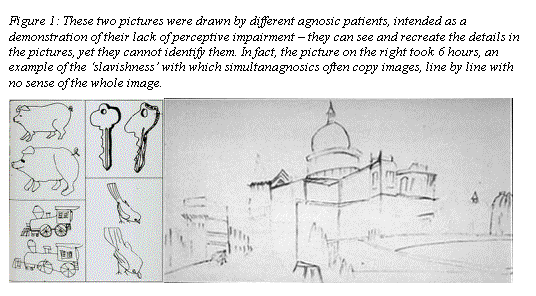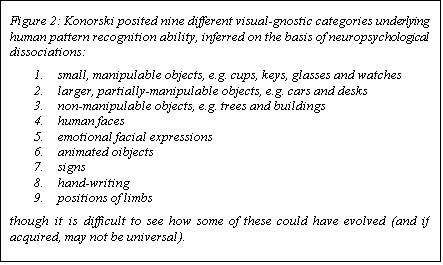What do we learn about visual perception from agnosias?
Greg Detre
Thursday, 11 May, 2000
Brain & Behaviour � Prof Rolls
The term agnosia can simply mean �a diminished ability to recognize objects by one or other of the senses�, but this understates the higher-level deficiencies at the root of the problem. More strictly, visual agnosia is a broad term which refers to a multiplicity of conditions affecting a subject�s ability to �see�, in the sense of being able to process a visual scene, identify and place objects, and form a meaningful mental representation of the scene as a whole. To use Teuber�s expressive phrase, theirs is �a normal percept, stripped of its meaning�.
One of the most striking things about the diverse group of agnosias is how reminiscient they are of defects in a computer program. One can almost imagine that very similar problems might arise if a computer program functionally similar to human vision had chunks of code deleted from it at random. This emphasises the constructed, information-processing nature of our visual system. Moreover, it gives hope that the disorders might be fairly easily understandable in terms of a computational model.
I will follow Martha Farah�s taxonomy (from �Visual Agnosia�, MIT, 1990), based on a comprehensive review of case reports of agnosia. As she points out, it is only fairly recently that agnosias have been recognised as definitely existing, and not resulting from some lower-level defect, such as lack of acuity, colour-blindness, problems with areas in the visual field. She draws a distinction between apperceptive and associative agnosias, not on the basis of the extent to which perception is impaired (Lissauerr), but between agnosia with different kinds of visual impairments. Although I am focussing on the visual agnosias unrelated to parietal problems, I will first outline the whole range of agnosias.
Apperceptive agnosics fall into three categories: narrow, dorsal simultanagnosia and ventral simultanagnosia:
1. Narrow apperceptive agnosics have unimpaired colour perception, acuity, naming ability and semantic processing but seem unable to process, recognise, copy or match shape. They often use form from motion to help them, by moving their hands and eyes or the object itself, and seem to be able to preserve the elementary dimensions. This condition is usually associated with a diffuse and posterior neuropathology, such as the case of Mr S, a young man who suffered accidental carbon monoxide poisoning.
2. Dorsal simultanagnosics don�t seem to have especial difficulty with shape. Instead, their visual attention seems to filter out all but a single object present in the visual field (although, subjects can sometimes see more than one object, if the objects are located closely together in the visual angle). Alternatively, the parietal damage that most of these subjects seem to suffer might explain the attention-stickiness as an inability to disengage attention from an object. The fact that they see objects as a whole indicates that the object-identification and feature grouping processes appear to be functioning correctly. They talk about different objects appearing and disappearing beyond their volition. Top-down information can influence this pre-attentive filtering, so the subject might first perceive wheels, handlebars and a saddle before guessing they were seeing a bicycle, at which point the components coalesce to form a single object composed of a group of objects. Dorsal simultanagnosics seem almost blind, since they are unable to localise the single objects that their attention is stuck to.
3.

Ventral simultanagnosia is similar to dorsal simultanagnosia, and they are
often confused in the literature. The major difference is that the patient can
see the whole scene, but cannot recognise more than one object at once, e.g.
letter-by-letter or feature-by-feature. This generally follows left imferior
temporo-occipital damage.
The associative agnosics� difficulties are in naming a seen objects, again despite serious visual impairments.:
1.

Narrow associative visual object agnosics cannot name or even indicate
recognition of any visually-presented object, even though their naming of
tactile and auditory stimuli is relatively unimpaired. They cannot indicate
recognition of a seen object verbally or non-verbally, despite evidence from
detailed drawing (though done slowly and line-by-line) that their basic
perceptual abilities are up to the task.
2. Pure alexia is a selective impairment in reading, with normal writing and aural language comprehension. When pure alexics can read at all, they do so letter by letter.
3. Prospagnosia is the inability to recognise faces, despite generally intact visual perception.
4. Optic aphasics, like associative agnosics, have difficulty naming objects when presented visually, though they are able to demonstrate recognition, e.g. by making a pantomime to indicate the object�s usage. There does not appear to be a problem with their naming mechanism, since they have no problems naming objects presented non-visually, i.e. tactile or auditory.
Farah�s taxonomy shows how the term agnosia covers a confusing array of conditions, varying from low-level perception problems, grouping and form discrimination difficulty, to parietal lesions and �stickiness� of visual attention.